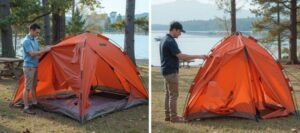Camping in a tent allows you to experience the great outdoors up close, but chilly nights or uncomfortable setups can quickly turn an adventure into a miserable experience. With proper preparation, you can enjoy warm and cozy nights no matter the season. In this guide, we’ll share practical tips to keep you warm and comfortable in your tent.
Choose the Right Tent for the Conditions
The tent you choose plays a significant role in staying warm and comfortable. Not all tents are created equal, so consider these factors:
Seasonal Ratings
- 3-Season Tents: Ideal for spring, summer, and fall. They offer ventilation but may not hold up in extreme cold.
- 4-Season Tents: Designed for winter camping. These tents provide extra insulation and can withstand snow and strong winds.
Size Matters
- A tent that’s too large can make it harder to retain heat. For colder conditions, choose a tent that closely matches the number of occupants.
Ventilation
- Proper ventilation reduces condensation, which can make you feel damp and colder. Look for tents with adjustable vents.
Insulate the Ground Beneath You
The cold ground is one of the main culprits for heat loss when camping. Proper insulation is key to staying warm:
Use a Ground Tarp or Footprint
- Place a tarp or tent footprint underneath your tent to create a barrier against moisture and cold.
Sleeping Pad or Mattress
- A high-quality sleeping pad is essential. Look for:
- Foam Pads: Lightweight and durable.
- Inflatable Pads: Provide better cushioning and insulation (check the R-value for warmth rating).
Choose the Right Sleeping Bag
Your sleeping bag is your primary defense against cold temperatures. Here’s how to pick the best one:
Temperature Rating
- Check the bag’s temperature rating to ensure it matches the conditions of your trip. Opt for a sleeping bag rated slightly below the expected temperature for added warmth.
Shape and Material
- Mummy Bags: Snug fit that traps heat effectively.
- Down Fill: Lightweight and warm but loses insulation when wet.
- Synthetic Fill: Retains warmth even in damp conditions.
Layer Up for Warmth
Wearing the right clothing inside your tent can make all the difference:
Base Layer
- Wear moisture-wicking thermal underwear to keep sweat off your skin.
Mid Layer
- Add fleece or wool layers for insulation.
Outer Layer
- If it’s particularly cold, wear a lightweight down jacket inside your sleeping bag for extra warmth.
Socks and Hats
- Wool socks and a beanie are essential, as much of your body heat escapes through your feet and head.
Warm Up Your Sleeping Space
A few simple steps can transform your tent into a warm haven:
Hot Water Bottle Trick
- Fill a durable, leak-proof water bottle with hot water and place it in your sleeping bag before bed. Focus on areas like your feet or core for maximum warmth.
Use a Tent Heater (Safely)
- Portable tent heaters can add significant warmth, but always follow safety guidelines and never leave them unattended.
Blankets and Liners
- Add an extra layer of insulation by using a sleeping bag liner or packing a camping blanket for added warmth.
Eat and Stay Hydrated
Your body generates heat through the calories you consume. Eating the right foods and staying hydrated are crucial:
Eat Before Sleeping
- Enjoy a warm, calorie-dense meal before bed. Foods like pasta, rice, or soups provide slow-burning energy to keep you warm throughout the night.
Stay Hydrated
- Dehydration makes it harder for your body to regulate temperature. Drink warm beverages, like tea or hot cocoa, to stay hydrated and cozy.
Combat Condensation
Waking up to a damp sleeping bag or tent can make you feel colder. Here’s how to avoid condensation:
Ventilate Your Tent
- Leave vents or windows slightly open to promote airflow and reduce moisture buildup.
Avoid Wet Gear
- Keep wet clothes and gear outside the sleeping area. Use a vestibule or dry bag to store damp items.
Prepare for Unexpected Cold
Weather can be unpredictable, so it’s always a good idea to be prepared for sudden temperature drops:
Extra Layers
- Pack more clothing than you think you’ll need. It’s better to have an extra sweater or thermal shirt than to be caught unprepared.
Emergency Blankets
- Compact and lightweight, space blankets are excellent for retaining heat in unexpected situations.
Use Nature to Your Advantage
Your campsite can impact how warm you stay at night:
Choose a Sheltered Spot
- Set up your tent in an area protected from wind, such as near trees or large rocks.
Use the Sun
- Position your tent to catch the morning sun to warm it up naturally.
Avoid Low Areas
- Cold air settles in valleys and low-lying areas, so choose higher ground for camping.
Develop a Cozy Bedtime Routine
Warming up before bed ensures you’ll feel comfortable when you crawl into your sleeping bag:
Exercise Lightly
- Do a few jumping jacks or jog in place to raise your body temperature, but avoid sweating.
Change Into Dry Clothes
- Always wear fresh, dry clothing to bed. Damp clothes from the day will make you colder.
Wind Down
- Warm beverages like herbal tea or hot chocolate can help relax your body and prepare you for sleep.
Enhance Your Camping Comfort
If staying warm in your tent is a priority, you might also want to check out our guide on how to choose the perfect tent for your camping style. Selecting a tent that suits your needs is the first step toward a comfortable night outdoors.
For those braving colder conditions, learn more about 4-season tents: the best choices for year-round adventures. These tents are designed to withstand harsh weather, providing extra insulation and durability.
Final Thoughts
Staying warm and comfortable in a tent doesn’t have to be a challenge. With the right gear, preparation, and knowledge, you can enjoy a cozy night under the stars even in chilly conditions. Remember, the key is layering, insulation, and staying dry.
By following these tips, you’ll be ready to embrace the joys of camping without worrying about the cold. So pack your gear, plan ahead, and get ready to enjoy a warm, comfortable tent experience!
Reviewed and updated on 01/24/2025




